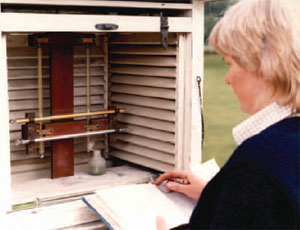Temperature
ContentThe normal method of measuring the air temperature uses a vertically mounted mercury-in-glass thermometer that is able to read to the nearest 0.1°C. In order to obtain an accurate result, thermometers used must be protected from direct radiation i.e. the readings must be made 'in the shade'.
The dry bulb thermometer is paired with a wet bulb thermometer that has, around its bulb, a muslin bag kept wet with distilled water. In combination, they are used to determine the humidity (see below). Robust mercury-in-glass thermometers set in sleeves are also used to determine soil temperatures; temperatures both at the soil surface and at 300 mm depth are usually recorded in agro- meteorological stations. The highest and lowest temperatures over the day (and night) are recorded on the Max-Min (maximum and minimum) thermometers (see Figure 2.12) mounted horizontally on the fl oor of the screen. The maximum thermometer is a mercury-in-glass design, but with a constriction in the narrow tube near the bulb that contains the mercury. This allows the mercury to expand as it warms up, but when temperatures fall the mercury cannot pass back into the bulb and so the highest temperature achieved can be read off ('today’s high’). Shaking the contents back into the bulb resets it. The minimum thermometer contains alcohol. This expands as it warms but as it contracts to the lowest temperature ('tonight’s low’) a thin marker is pulled down by the retreating liquid. Because it is lightly sprung, the marker is left behind whenever the temperature rises. Using a magnet, or tilting, to bring the marker back to the surface of the liquid in the tube, can reset the thermometer. In addition to the screen reading, there are other lowesttemperature thermometers placed at ground level giving 'over bare soil' and 'grass’ temperatures (see Figure 2.1). |





